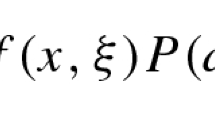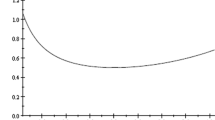Abstract
This paper gives a comprehensive treatment of EVPI-based sequential importance sampling algorithms for dynamic (multistage) stochastic programming problems. Both theory and computational algorithms are discussed. Under general assumptions it is shown that both an expected value of perfect information (EVPI) process and the corresponding marginal EVPI process (the supremum norm of the conditional expectation of its generalized derivative) are nonanticipative nonnegative supermartingales. These processes are used as importance criteria in the class of sampling algorithms treated in the paper. When their values are negligible at a node of the current sample problem scenario tree, scenarios descending from the node are replaced by a single scenario at the next iteration. On the other hand, high values lead to increasing the number of scenarios descending from the node. Both the small sample and asymptotic properties of the sample problem estimates arising from the algorithms are established, and the former are evaluated numerically in the context of a financial planning problem. Finally, current and future research is described. Bibliography: 49 titles.
Similar content being viewed by others
REFERENCES
K. Back and S. R. Pliska, “The shadow price of information in continuous-time decision problems,” Stochastics, 22, 151–186 (1987).
B. Bereanu, “On stochastic linear programming II: Distribution problems. Non-stochastic technology matrix,” Rev. Roumaine Math. Pures Appl., 11, 713–725 (1966).
B. Bereanu, “On stochastic linear programming: Distribution problems. Stochastic technology matrix,” Z. Wahrscheinlichkeitstheor. Verw. Geb., 8, 148–152 (1967).
P. Billingsley, Probability and Measure, 2nd edition, Wiley, New York (1980).
J. R. Birge, M. A. H. Dempster, H. I. Gassmann, E. A. Gunn, A. J. King, and S. Wallace, “A standard input format for multiperiod stochastic linear programs,” Committee on Algorithms Newsletter, 17, 1–20 (1987).
M. J. Brennan, E. S. Schwartz, and R. Lagnado, “Strategic asset allocation,” J. Econom. Dynam. Control, 21, 1377–1403 (1997).
Z. Chen, G. Consigli, M. A. H. Dempster, and N. Hicks Pedron, “Towards sequential sampling algorithms for dynamic portfolio management,” in: [49], pp. 197–211.
X. Corvera Poire, Model Generation and Sampling Algorithms for Dynamic Stochastic Programming. Ph.D. Thesis, Department of Mathematics, University of Essex (1995).
X. Corvera Poire, STOCHGEN User's Manual, Department of Mathematics, University of Essex (1995).
J. W. Daniel, The Approximate Minimization of Functionals, Prentice-Hall, Englewood Cliffs, New Jersey (1971).
G. B. Dantzig and P. W. Glynn, “Parallel processors for planning under uncertainty,” Ann. Oper. Res., 22, 1–21 (1990).
G. B. Dantzig and G. Infanger, “Large-scale stochastic linear programs: Importance sampling and Benders decomposition,” Technical Report SOL 91-4, Department of Operations Research, Stanford University, Stanford, California (1991).
G. B. Dantzig and A. Madansky, “On the solution of two-stage linear programs under uncertainty,” in: Proceedings of the Fourth Symposium on Mathematical Statistics and Probability, Vol. I, University of California, Berkeley (1961), pp. 165–176.
M. H. A. Davis, M. A. H. Dempster, and R. J. Elliott, “On the value of information in controlled diffusion processes,” in: [33], pp. 125–138.
M. A. H. Dempster (ed.), Stochastic Programming, Academic Press, London (1980).
M. A. H. Dempster, “The expected value of perfect information in the optimal evolution of stochastic systems,” in: Stochastic Differential Systems, M. Arato, D. Vermes, and A. V. Balikrishnan (eds.), Springer, Berlin (1981), pp. 25–40.
M. A. H. Dempster, “On stochastic programming: II. Dynamic problems under risk,” Stochastics, 25, 15–42 (1988).
M. A. H. Dempster and R. T. Thompson, “EVPI-based importance sampling solution procedures for multistage stochastic linear programmes on parallel MIMD architectures,” Ann. Oper. Res., 90, 161–184 (1999).
D. Dentcheva and W. Romisch, “Differential stability of two-stage stochastic programs,” Preprint No. 96-36, Institute of Mathematics, Humboldt University, Berlin (1996).
O. Fiedler and W. Romisch, “Stability in multistage stochastic programming,” Ann. Oper. Res., 56, 79–93 (1995).
H. I. Gassmann, “MSLiP: A computer code for the multistage stochastic linear programming problem,” Math. Program., 47, 407–423 (1990).
N. Hicks Pedron, Model-Based Asset Management: A Comparative Study, Ph.D. Thesis, Judge Institute of Management Studies, University of Cambridge (1998).
J. L. Higle and S. Sen, “Stochastic decomposition: An algorithm for two stage linear programs with recourse,” Math. Oper. Res., 16, 650–669 (1991).
J. L. Higle and S. Sen, Stochastic Decomposition: A Statistical Method for Large Scale Stochastic Linear Programming, Kluwer Academic Publishers, Dordrecht (1996).
G. Infanger, Planning under Uncertainty: Solving Large-Scale Stochastic Linear Programs, Boyd & Fraser, Danvers, Massachusetts (1994).
A. J. King, Asymptotic Behaviour of Solutions in Stochastic Optimization: Nonsmooth Analysis and the Derivation of Non-Normal Limit Distributions, Ph.D. Thesis, Department of Mathematics, University of Washington (1986).
A. J. King, “Generalized delta theorems for multivalued mappings and measurable selections,” Math. Oper. Res., 14, 720–736 (1989).
A. J. King, “Martingales and duality in contingent claims analysis: The discrete case,” Research Report RC21153, IBM Research Division, T. J. Watson Research Center, Yorktown Heights, New York (1998).
A. J. King and R. T. Rockafellar, “Asymptotic theory for solutions in statistical estimation and stochastic programming,” Math. Oper. Res., 18, 148–162 (1993).
M. Lane and P. Hutchinson, “A model for managing a certificate of deposit portfolio under uncertainty,” in: [15], pp. 473–493.
W. K. Mak, D. P. Morton, and R. K. Wood, “Monte Carlo bounding techniques for determining solution quality in stochastic programs,” Research Report, Department of Computer Science, University of Texas at Austin (1997).
H. M. Markowitz, Portfolio Selection, Efficient Diversification of Investments, 2nd edition, Blackwell, Oxford (1987).
E. Mayer-Wolf, E. Merzbach, and A. Schwartz, Stochastic Analysis, Academic Press, New York (1991).
V. I. Norkin, G. C. Pflug, and A. Ruszcynski, “A branch and bound method for stochastic global optimization,” Working Paper WP-96-065, International Institute for Applied Systems Analysis, Laxenburg, Austria (1996).
P. Olsen, “Discretizations of multistage stochastic programming problems,” Math. Program. Studies, 6, 111–124 (1976).
G. Ch. Pflug, Optimization of Stochastic Models: The Interface Between Simulation and Optimization, Kluwer, Boston (1996).
A. Prekopa, “Laws of large numbers for random linear programs,” Math. Systems Theory, 6, 277–288 (1972).
S. T. Rachev, Probability Metrics and the Stability of Stochastic Models, Wiley, New York (1991).
H. Raiffa, Decision Analysis, Addison-Wesley, Reading, Massachusetts (1968).
R. T. Rockafellar and R. J.-B. Wets, “Nonanticipativity and L1-martingales in stochastic optimization problems,” Math. Program. Studies, 6, 170–186 (1976).
R. T. Rockafellar and R. J.-B. Wets, “A Lagrangian finite generation technique for solving linear-quadratic problems in stochastic programming,” Math. Program. Studies, 28, 63–93 (1986).
W. Romisch, “Quantitative stability of stochastic programs,” Presented at 16th International Symposium on Mathematical Programming, Lausanne (1997).
R. Y. Rubinstein and A. Shapiro, Discrete Event Systems: Sensitivity Analysis and Stochastic Optimization by the Score Function Method, Wiley, New York (1993).
G. Salinetti and R. J.-B. Wets, “On the distribution of measurable multifunctions (random sets), normal integrands, stochastic processes and stochastic infima,” Math. Oper. Res., 11, 385–419 (1986).
A. Shapiro, “Asymptotic analysis of stochastic programs,” Ann. Oper. Res., 30, 169–186 (1991).
A. Shapiro, “Asymptotic behaviour of optimal solutions in stochastic programming,” Math. Oper. Res., 18, 829–845 (1993).
A. Shapiro, “Simulation-based optimization: Convergence analysis and statistical inference,” Commun. Stat., Stochastic Models, 12, 425–454 (1996).
R. T. Thompson, MSLiP-OSL 8.3 User's Guide, Judge Institute of Management Studies, University of Cambridge (1997).
C. Zopounidis (ed.), Operational Tools in the Management of Financial Risks, Kluwer, Dordrecht (1997).
Author information
Authors and Affiliations
Additional information
__________
Published in Zapiski Nauchnykh Seminarov POMI, Vol. 312, 2004, pp. 94–129.
Rights and permissions
About this article
Cite this article
Dempster, M.A.H. Sequential Importance Sampling Algorithms for Dynamic Stochastic Programming. J Math Sci 133, 1422–1444 (2006). https://doi.org/10.1007/s10958-006-0058-1
Received:
Issue Date:
DOI: https://doi.org/10.1007/s10958-006-0058-1




